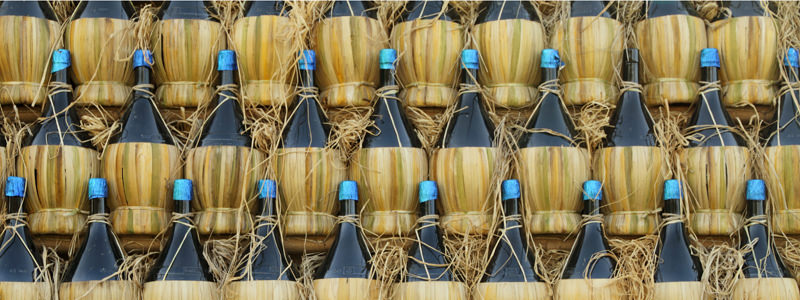Chianti is the historical $1 slice of pizza of Italy. It’s been around since the Italian Renaissance, wild variations in quality exist, and now the hipsters are into it. In fact, Chianti is so hip these days, the Consorzio Vino Chianti Classico established an entirely new level of quality in 2014, “Chianti Classico Gran Selezione.” This is Chianti’s attempt at creating a “cru” wine similar to crus in Burgundy and it’s equivalent to getting artisanal, organic, wood-fired, gluten-free pizza drizzled with truffle oil, baby kale, and gold flake at 2am.
Don’t get me wrong, Gran Selezione wines are delicious at any time of day or night, but like that pizza, you’re going to pay for it. Things certainly aren’t how they used to be.
For most Chianti, this change is a good thing.
In essence, Chianti was a disaster for its first several decades in the United states. In fact, the classic straw basket that enclosed the region’s round bottles is quite aptly named a fiasco.
Blanched straw wrapped around these iconic bottles served two purposes: easy-to-blow–over round bottles could now stand up straight, and the baskets added protection during shipping. In short, fiaschi were cheap and easy–like most elements of early Chianti.
At heart, Chianti is a richly aromatic red from Tuscany’s rolling hills between the cities of Florence and Siena. Most Italians (and wine lovers) agree that Chianti is about showcasing the Sangiovese grape, which has fantastic, bright acidity and gives medium-bodied reds delicious cherry flavors. Despite its light color and penchant for astringency, the tiny red grape has been a staple in Tuscan vineyards since the 1300s. At its geographical core lies Chianti Classico, the small, historic home of these wines which showcase Sangiovese and its earthy glory.
The Consorzio which invented the Gran Selezione level of Chianti also regulates wines simply labeled “Chianti” and “Chianti Classico,” and since its birth in 1924 the group has changed the rules of the Chianti game repeatedly.
For instance, when a global demand for inexpensive wine emerged after WWII, regulators expanded the geographic borders of Chianti, and allowed 20% white grapes to be blended into Chianti reds–turning Sangiovese-based bliss into dilute, dull reds that inspired daydreams of six packs instead of Mediterranean hills.
In essence, that’s like telling every pizza place in New York that only deep dish pies are allowed, and then demanding the deep dish pizzas cook in just five minutes. Instead of defining style and quality, rules like this pushed producers to make bulk wines, encouraging shortcuts and poor practices in the winery.
In the US, Chianti was very quickly being passed over by wine drinkers because of its unreliable quality. Meanwhile, California’s wine industry was expanding and advances in vineyard and winery science were allowing American wines to compete with Italian Sangiovese on price, while delivering reliable quality. France was doing the same thing.
As astringent, bitter baskets of wine were getting dusty on American store shelves a few intrepid Italian winemakers were returning to Sangiovese, this time blending it with Bordeaux varieties like Cabernet Sauvignon. This was all because in 1967 when Chianti Classico received strict DOC status they formalized the Chianti recipe, which included not only the allowance of white grapes in the blend, but also told winemakers what else could and could not be included, which restricted many creative winemakers. So these rebels went out on their own, making wines they wanted to make, without worrying about them being labeled Chianti. This innovation led to the birth of full-bodied Super Tuscans, and their triple-digit price tags helped convinced other Chianti winemakers that quality was possible and, at long last, a revival ensued.
The 1984 elevation of Chianti from DOC to DOCG and then the 1996 creation of Chianti Classico DOCG were the catalysts that helped remove the cheap white wine from the blend and bring the focus of the wine back to Sangiovese.
These new regulations made quality paramount, especially in Chianti Classico, and winemakers returned to high standards that had defined the region in the Renaissance. As they began competing with European and American producers, down went the fiasco and in came the square-shouldered Bordeaux bottle–making Chianti look as good as it could taste.
As of 2013, the United States is the number one importer of Chianti, buying up 31% of the region’s annual production. Meanwhile, modern, Chianti-style Sangioveses are being replicated in California and Texas with wild success.
Now, with prime examples popping up everywhere, these earthy, cherry-laden reds are strutting their stuff alongside more than pizza and pasta. Steaks, burgers, and even summer vegetables like eggplant are natural complements to Chianti, and balance out the wine’s hearty tannins.
With grills being dusted off across America, give Chianti a chance instead of tossing back the same old sangria this summer. Look for labels with the abbreviation “DOCG,” which guarantees the wine adheres to the region’s quality regulations. Tasty options from classic producers, like Ruffino and Monsanto, abound in the $15-$25 range. And remember, if it comes in a fiasco, it probably is one.

